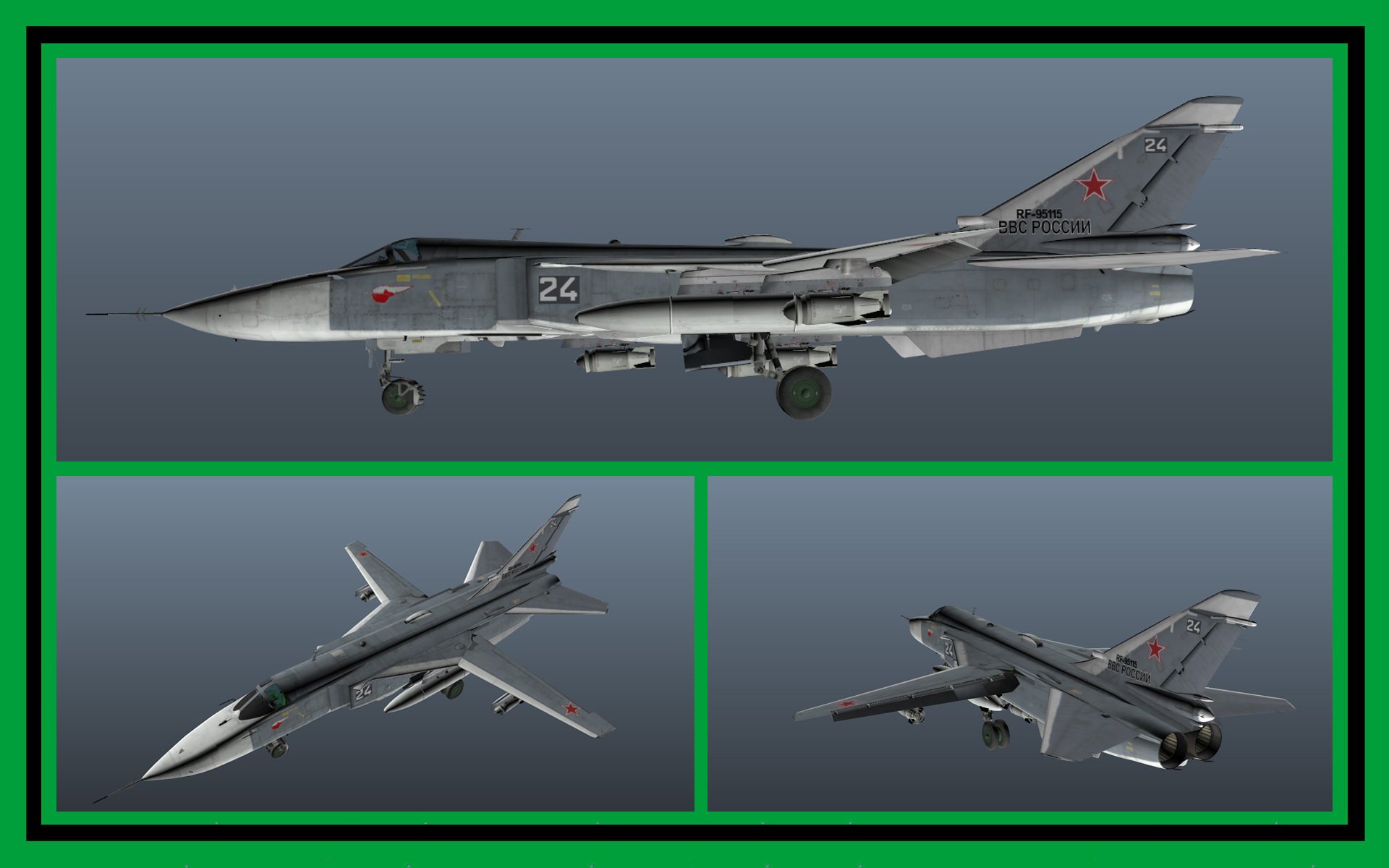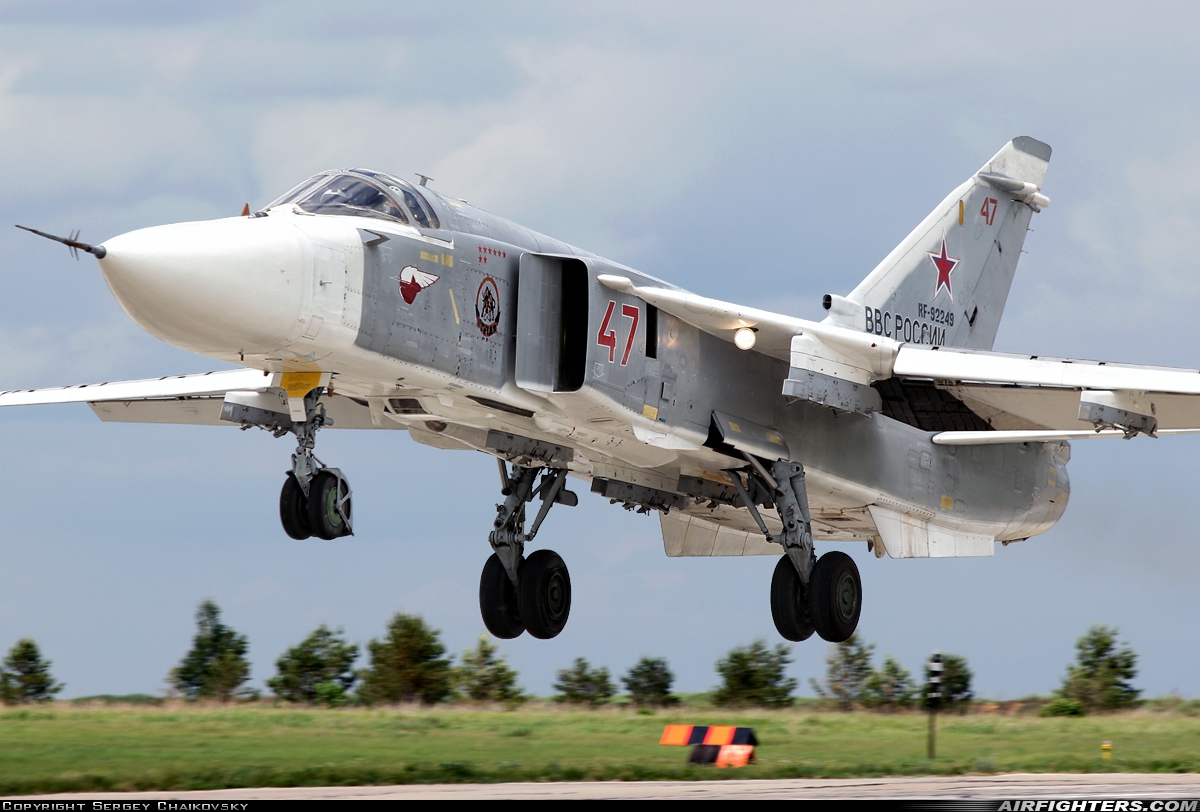Sukhoi 24 Aircraft - | The Su-24 remains a powerful long-range low-altitude attack aircraft with a truly accurate strike potential in any weather. With its variable geometry swiveling wing and side-by-side cockpit, the Su-24 is inevitably compared to the US General Dynamics F-111 fighter. The aircraft was never intended or used as a strategic bomber, but these comparisons overshadow the facts. The Su-24 is more broadly equivalent to the Anglo-German-Italian Tornado.
The Fencer is intended to replace the Yak-28 in the all-weather, low-powered ground attack and tactical strike role. The aircraft can carry up to 8,000 kg of ammunition, but its normal payload is around 4,000 kg. It is designed to carry the TN-1000 and TN-1200 nuclear free-fall bombs, as well as various conventional free-fall bombs, missiles and air-to-surface missiles to engage stationary and moving targets with high accuracy. Although it was optimized as a supersonic bomber, it was also intended for a secondary photo reconnaissance role and to replace Brewer in the electronic warfare role.
Sukhoi 24 Aircraft

Design for what became the Su-24 began in the early 1960s, however Sukhoi abandoned his original design (an enlarged twin-engine aircraft based on the Su-7 layout but with a tandem cockpit) in favor of the Delta. Complex T6. It had a fuselage-mounted jet lift to improve takeoff and landing performance. However, the elevator planes were heavy and unwieldy and the T6 was redesigned six months later.
Ukrainian Air Force Shot Down Three Su 24 Bombers And An Su 25 Attack Aircraft
The resulting T-6-21G prototype had no jet lift (leaving more room for fuel and armament), but had a VG swiveling wing. This was added to improve takeoff and landing performance. The aircraft made its first flight in May 1970, and at the end of 1970, serial production of the Su-24 was ordered.
Production of the Su-24 entered service in 1973. The Su-24 was deployed as part of the Soviet group of forces in Germany in 1979 and in Poland. Since 1984, Su-24s have been actively involved in the war in Afghanistan.
The original Su-24 underwent minor configuration changes during production and this led to three reporting names (Fencer-A to -C) being assigned to it by NATO ASCC. The aircraft was fast and stable at low altitudes and could carry an impressive combat load (albeit only at the cost of range), but its avionics were poorly developed and unreliable. Therefore, the aircraft could never be compared with the western attack aircraft.
The updated Su-24M (Fechtovalshchik-D) was a significantly improved aircraft and entered service in 1986. The Su-24M received improved avionics with an Orion-A guidance system and a radar assistance system. It also has a laser vision system and a Kaira 24 TV that offers PGM compatibility. The Fencer-D has a retractable probe above the nose and can carry a friend's supply magazine in the center line.
Russia's Su 24 Didn't Violate Turkish Air Space
Su-24MR (Fehtovalshchik-E) is a special tactical reconnaissance variant. It entered service in 1983. It lacks strike radar, cannon, and strike avionics, and supports panoramic cameras, side-scan airborne radar, and infrared reconnaissance systems. It also carries other sensory blocks. Data from the cold sensor will be transmitted in real time to the ground station. This reconnaissance aircraft can carry two P-60 (AA-8 Aphid) air-to-air missiles for self-defense. Production of the Su-24MR was discontinued in 1993. At least a hundred of these tactical reconnaissance aircraft were built.
Su-25MP (Fencer-F) is a special version of the RTR. It was developed from the Su-24MR. The Fencer-F entered service in 1983. It has additional sensors for gathering intelligence. Various SIGINT and ECM blocks can be carried. It is armed with cannons and has the capability of mounting four R-60 air-to-air missiles. A total of 10-20 such aircraft were built.
At least 670 Su-24s should be built. The total number can be from 900 to 1200. Fencer-B, -C, -D and -E are still widely used on the fronts in Russia and various countries of the former USSR. Degraded non-nuclear Su-24MK were exported to Algeria, Iran, Iraq, Libya and Syria.

The old Su-24 is being replaced by the new Su-34 long-range interceptor, which is a derivative of the Su-27 air superiority fighter. It was adopted by the Russian Air Force. The modernization program for surviving Russian Su-24s is ongoing to extend their service life. The recently upgraded aircraft was named Su-24M2. Although the Su-24 was developed in the mid-1960s, it is still used by a number of armed forces, mainly from Russia, the former Soviet bloc and other countries. who were friendly with the Soviet Union, but also with Iran, given them security by Iraq before the 1991 invasion, and they never returned.
Sukhoi Su 24 Fencer
The Su-24 is primarily a low-flying medium-range attack aircraft for ground support. Its similarity to the F-111 Aardvark of General Dynamics is not accidental - both aircraft were developed at the same time (although the Su-24 was built as a response to the F-111 Aardvark, so the F-111 precedes the Su-24). 24 a bit). Both aircraft have a similar mission profile and are therefore strikingly similar in both appearance and capability.
The Su-24 has a crew of two and uses a side-by-side seating arrangement whereby the pilot and weapons system navigator sit side-by-side in the cockpit, rather than one behind the other, in typical combat mode. This design requirement was dictated by the large antennas of the Su-24 radar.
One of the Su-24's unique features is its wings, which use a variable-sweep design where the wings can "track" or unfold depending on the required flight characteristics.
For takeoff and landing, a sweep of 16 degrees is optimal, which provides better lift and control at low speeds. A sweep of 35 or 45 degrees is ideal for normal (altitude dependent) flight, while 69 degrees is ideal for high-speed, low-altitude flight.
This Is The Russian Plane That Turkey Just Shot Down
With the Su-24, the Soviet Union gained an all-weather day and night attack aircraft thanks to an airborne ground-based radar that could automatically maintain the Su-24's altitude to stay out of sight of the enemy.
Looking at the Sukhoi website, it explains: “The T-6 [Su-24 prototype] was the first tactical aircraft in the USSR to provide round-the-clock use in any weather. This was achieved thanks to the installation of the Puma PNA, which included a dual-band sighting radar” Orion-A" and specialized radar "Relief", designed to provide flight automation with coverage of the terrain at low and ultra-low altitudes.
In 2015, two Russian Su-24s, operating in Syria as part of the Russian military presence in the country, went missing in Turkey. While one of the Su-24s left the area after being contacted by Turkish air traffic controllers, the other did not.

Turkey took to the air two F-16 fighters, one of which fired at the Su-24, shooting down the plane. Both the pilot and weapons officer successfully ejected, although one of the crew members was apparently knocked off the ground by insurgent forces and killed.
Aircraft Photo Of Rf 33770
Another Russian serviceman died in a subsequent rescue attempt. This was the first time that Russia and a NATO member have come into direct conflict during the Syrian civil war.
While a downing isn't exactly an indicator of an aircraft's combat capability, for better or worse, the Su-24 platform continues to fly.
Caleb Larson is an advocacy writer representing the national interest. He has a master's degree in public policy and focuses on US and Russian security issues, European defense issues, and German politics and culture. The main section of this article may be too short to properly summarize the key points. Consider expanding the manual to provide an accessible overview of all important aspects of the article. (June 2022)
The Sukhoi Su-24 (NATO reporting name: Fcer) is a supersonic all-weather attack aircraft developed in the Soviet Union. The aircraft has a variable sweep wing, two engines and a side seat for a crew of two. It was the first aircraft in the USSR to carry an integrated navigation and digital attack system.
Iriaf Su 24 Attack Aircraft Returns To Service
It remains in service with the Russian Air Force, Syrian Air Force, Ukrainian Air Force, Algerian Air Force, and various other air forces to which it was exported.
One of the conditions for the adoption of the Su-7B in service in 1961 was the requirement for Sukhoi to develop an all-weather version capable of delivering pinpoint air strikes. Preliminary studies of the S-28 and S-32 aircraft showed that the basic design of the Su-7 was too small to contain all the avionics needed for the mission.
Was commissioned to develop an advanced navigation / attack system, codenamed Puma, which was to be the heart of the new aircraft.

In the same year, the United States offered its new TFX all-weather strike fighter. The resulting F-111 will feature a variable geometry wing to greatly increase payload, range and low-altitude flight capabilities.
Russia's Su 24 Truly Is A 'blast' From The Past
In 1962-1963, Sukhoi originally intended to build an aircraft without such complex movable wings as the F-111. He designed and built a model of the S-6, a hang glider with two Tumansky R-21 turbojet engines and a crew of two in tandem layout. The layout was inspected, but no further work was ordered due to lack of progress on Puma's equipment.
In 1964, Sukhoi began work on the S-58M. The aircraft was supposed to reproduce a modification of the Su-15 interceptor (factory designation S-58). Meanwhile, the revised requirements of the Soviet Air Force called for the creation of a low-altitude attack aircraft with a runway.
Sukhoi passenger aircraft, sukhoi 24, sukhoi aircraft designed, sukhoi aircraft company, sukhoi military aircraft, sukhoi commercial aircraft, sukhoi aerobatic aircraft, sukhoi superjet 100 aircraft, sukhoi aircraft list, sukhoi civil aircraft, sukhoi 30 aircraft, sukhoi aircraft for sale

0 Comments